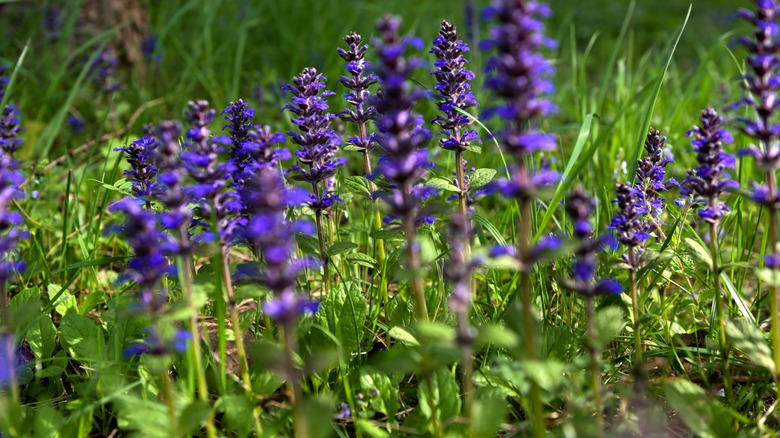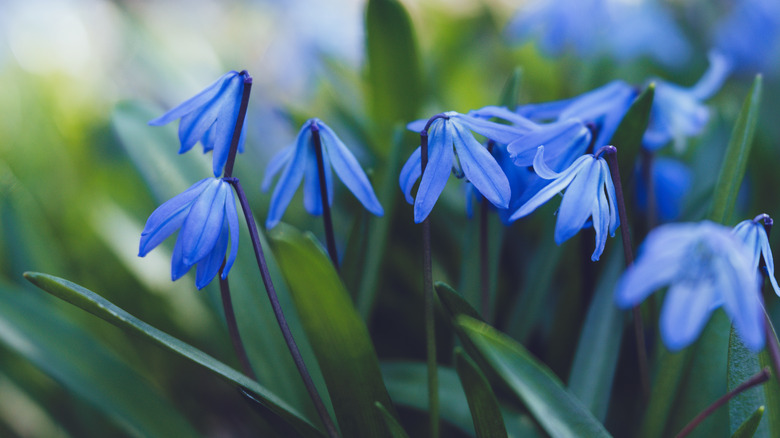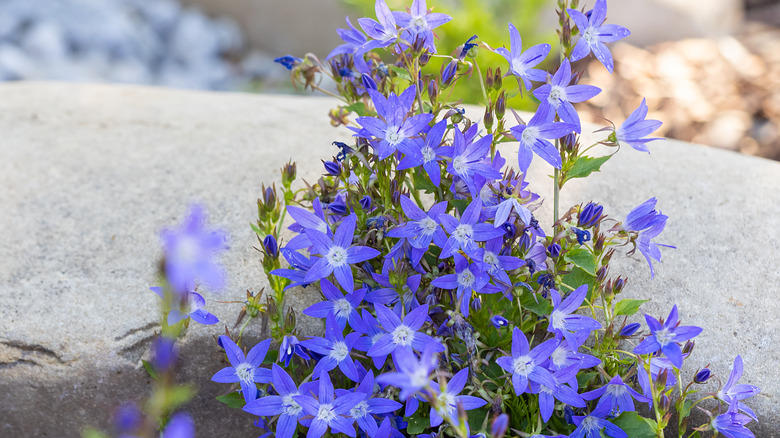Beautiful Blue Ground Cover Alternatives To Ajuga Bugleweed
Flowering ground covers can add beautiful colors to your yard. Whether covering a slope, enhancing the area beneath a tree, or tucked into corners of your flower bed, flowering ground covers are great for filling out hard-to manage spaces, and are often low-maintenance plants. Ajuga (Ajuga reptans), also called bugleweed, has lovely dark violet-blue flowers and flossy leaves, but some gardeners find that it spreads a bit too eagerly. So we've rounded up some ideas for blue-flowering ground covers and low-growing flowering plants that make a good alternative to ajuga.
One ground cover that puts out beautiful cobalt-blue flowers is leadwort(Ceratostigma plumbaginoides). This plant emerges in late spring and begins flowering in early to mid fall, adding lovely vivid color to the late season garden. It likes a variety of well-draining soil, and partial to full sun. It looks great tucked in between large rocks in a rock garden, or at the front of the late summer border. There are two different kinds of perennial phlox that have blue flowers: woodland phlox and creeping phlox. Woodland phlox grows about 10 to 12 inches tall, blooms for weeks in mid spring, and depending on the variety, has a range of blue flowers from pale blue to lavender blue. Creeping phlox is a late spring bloomer with needle like green foliage. It grows no more than 6 inches high, and comes in several shades of pale blue-violet, and blooms in late spring.
Low-growing blue flowering bulbs
In the spring, before most perennial ground covers emerge, there are a number of lovely blue-flowering bulbs that bloom early and can fill in for ground covers at the beginning of the season. Most of these are low growing, naturalize well in the garden, and will finish blooming before late spring. All of these blue-flowering bulbs can be planted in the fall.
Glory of the Snow (Chionodoxa forbesii) comes in white, pink, lavender, and powder blue shades. It's a cheery daisy-like flower that starts blooming in early spring, hence its name. Another blue flowering bulb that blooms early is Siberian squill (Scilla siberica). These cobalt blue star-shaped flowers are dainty but hardy, and if you plant a few in your lawn, they will eventually spread out and create a lush carpet of blue that blooms in mid spring, enjoying partial shade to full sun. Grecian windflowers (Anemone blanda), are periwinkle blue daisy-like flowers with yellow centers that bloom in late spring. Their hard bulbs may take a couple of years to start blooming reliably. Give them a compost rich soil and partial to full sun exposure for them to bloom their best. Another spring blooming blue flower is early stardrift (Puschkinia libanotica), a white star-shaped flower with stripes of deep blue that make the flowers look light blue from a distance.
Bellflowers
Summer-blooming bellflowers, which refer to various types of campanula, come in a wide range of blue and purple shades, as well as different shapes and sizes, including the popular balloon flowers (Platycodon grandiflorus), and Canterbury Bells (Campanula medium). There are some low-growing campanulas that make wonderful summer-flowering ground covers. The most popular blue flowering campanula that is often grown as a ground cover is known as Serbian bellflower (Campanula poscharskyana). This colorful plant is covered with violet blue trumpet-shaped flowers from early to late summer.
Another type of low-growing campanula is the Adriatic bellflower (Campanula garganica). This plant has several cultivars, including a gorgeous variety known as Dickson's Gold. It has greenish yellow leaves and delicate violet-blue flowers that bloom for weeks in summer. Plant several of these clumping plants together for a colorful ground cover in your summer flower beds. Give it plenty of sun and loamy soil for best results. Carpathian bellflowers, also known as Carpathian harebells, are bright violet-blue bell-shaped flowers on low-growing plants that top out at about 12 inches. This very cold hardy campanula starts blooming in early summer, and continues through the season until early autumn. Light deadheading of spent blooms will help keep it flowering all season long. This flower will bloom in partial shade to full sun, and makes a great ground cover planted beneath trees.


